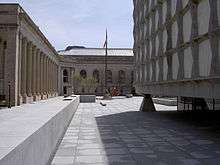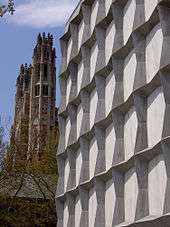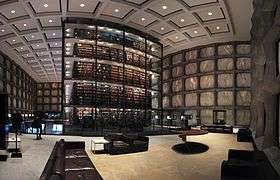Beinecke Rare Book & Manuscript Library

The Beinecke Rare Book & Manuscript Library is the rare book library and literary archive of the Yale University Library in New Haven, Connecticut. Situated on Yale University's Hewitt Quadrangle, the building was designed by Gordon Bunshaft of Skidmore, Owings & Merrill and completed in 1963.[1][2] Established by a gift of the Beinecke family and given its own endowment, the library is financially independent from the university and is co-governed by the University Library and Yale Corporation.[3]
The library's iconic building reopened in September 2016 after an 18 month closure for major renovations which included replacing the building's HVAC system and expanding teaching and exhibition capabilities.
Architecture


A six-story above-ground glass-enclosed tower of book stacks is surrounded by a windowless rectangular outer shell, supported only on four massive piers at the corners of the building, which descend 50 feet to bedrock. The outer walls are made of translucent veined marble panels quarried from Danby, Vermont, which transmit subdued lighting from outside, while providing protection from direct sunlight. At night, the stone panels transmit light from the interior, giving the exterior of the building an amber glow. The outside dimensions have "Platonic" mathematical proportions of 1:2:3 (height: width: length). The building has been called a precious "jewel box",[4][5] and also a "laboratory for the humanities".[3] The Modernist structure contains furniture designed by Florence Knoll.[6]
A public exhibition hall surrounds the glass stack tower, and displays among other things, one of the 48 extant copies of the Gutenberg Bible.[5] Two basement floors extend under much of Hewitt Quadrangle. The first level down, the "Court" level, centers on a sunken courtyard in front of the Beinecke, which features The Garden (Pyramid, Sun, and Cube). These are abstract allegorical sculptures by Isamu Noguchi that are said to represent time (the pyramid), sun (the disc), and chance (the cube).[7] This level also features a secure reading room for visiting researchers, administrative offices, and book storage areas. The level of the building two floors below ground has movable-aisle compact shelving for books and archives.[8]
The Beinecke is one of the largest buildings in the world devoted entirely to rare books and manuscripts. The library has room in the central tower for 180,000 volumes and room for over 600,000 volumes in the underground book stacks. The library's collection, which is housed both in the library's main building and at Yale University's Library Shelving Facility in Hamden, Connecticut, totals roughly 1 million volumes and several million manuscripts.[9]
During the 1960s, the Claes Oldenburg sculpture Lipstick on Caterpillar Tracks (Ascending) was displayed in Hewitt Quadrangle. The sculpture has since been moved to the courtyard of Morse College, one of the university's residential dormitories.
The elegance of the Beinecke later inspired the glass-walled structure that protects and displays the original core collection (the books gifted by King George III and referred to as the King's Library) within the British Library building in Euston, London.
History
In the late 19th century, rare and valuable books of the Library of Yale College were placed on special shelving at the College Library, now known as Dwight Hall. When the university received a multimillion-dollar bequest from John W. Sterling for the construction of Sterling Memorial Library in 1918, the university decided to create a dedicated reading room for its rare books, which became the building's Rare Book Room when the building opened in 1930. Because the bequest did not contain an allowance for books or materials, Yale English professor Chauncey Brewster Tinker petitioned Yale alumni to donate materials that would give the university a collection as monumental as its new building.[10] By the time Sterling opened, Tinker's appeal garnered an impressive collection of rare books, including a Gutenberg Bible from Anna M. Harkness and several major collections from the Beinecke family, most notably its collection on the American West.[10]
By 1958, the library owned more than 130,000 rare volumes and many more manuscripts.[10] The amassed collection proved too large for Sterling's reading room, and the reading room unsuited to their preservation. Having already given significant collections to Yale, Edwin and Frederick Beinecke—as well as Johanna Weigle, widow of their brother Walter—gave funds to build a dedicated rare books library building.[11] When the Beinecke Library opened on October 14, 1963, it became the home of the volumes from Rare Book Room, and three special collections: the Collection of American Literature, the Collection of Western Americana, and the Collection of German Literature. Shortly afterward, they were joined by the James Marshall and Marie-Louise Osborn Collection.
Beinecke Library became the repository for books in the Yale collection printed anywhere before 1800, books printed in Latin America before 1751, books printed in North America before 1821, newspapers and broadsides printed in the United States before 1851, European tracts and pamphlets printed before 1801, and Slavic, East European, Near and Middle Eastern books through the eighteenth century, as well as special books outside these categories.
Now, the collection spans through to the present day, including such modern works as limited-edition poetry and artists' books. The library also contains thousands of linear feet of archival material, ranging from ancient papyri and medieval manuscripts to the archived personal papers of modern writers.
Special collections


.jpg)
The library is open to all Yale University students and faculty, and to visiting researchers whose work requires use of its special collections. In order to access materials, there are a few forms and policies that users must read.[12]
The holdings of the Beinecke Library include:
Exhibitions
In addition to items on permanent display such as the Gutenberg Bible, the Beinecke offers a year-round program of temporary exhibits drawn from its collections.[14] For example, in 2006 the library presented Breaking the Binding: Printing and the Third Dimension, a show of flap books, pop-ups, perspective books, panoramas, and peep-shows in printed form. Display cases are located on the mezzanine level and at the ground floor entry level, and may be freely viewed by the general public whenever the library is open.
The Library celebrated its 50th anniversary in 2013.[15] There were two full-year exhibitions that explored the library's architecture and people as well as a series of showcases of rarely seen manuscripts, printed works, and visual objects from across all curatorial areas.[16]
Security
Security measures were significantly increased after the well-known antiques dealer Edward Forbes Smiley III was caught cutting maps from rare books with an X-acto blade in 2005. Smiley's scheme was discovered when he dropped his concealed tool in the reading room, and he subsequently served several years in prison for thefts of rare documents valued in millions of dollars from the Beinecke and other libraries.[17] The library operates under a closed stack system, and rigorous security rules now allow carefully controlled access to materials under video surveillance.[18]
The glass-enclosed central stacks (not accessible to the public) can be flooded with a mix of Halon 1301 and Inergen fire suppressant gas if fire detectors are triggered.[19] A previous system using carbon dioxide was removed for personnel safety reasons.[20]
After an infestation of the death watch beetle was discovered in 1977, the Beinecke Library helped pioneer the non-toxic method of controlling paper eating pests by freezing books and documents at −33 °F (−36 °C) for three days. All new acquisitions are given this treatment as a precaution and the deep freeze method is now widely accepted for pest control in special collections libraries .[8][19]
In popular culture
- In Uncommon Carriers, John McPhee admires a restaurant's display of "a glass tower of recumbent wines that may have been an architectural reference to the glass column of visible books in the Beinecke Library at Yale".[21]
- In The Once and Future Spy by Robert Littell, an assassination attempt is made on a CIA analyst at the Beinecke Library.
See also
Notes
- ↑ The Audubon collection includes two copies of the double elephant folio of Birds of America
- ↑ The Elizabethan Club collection is composed of about 300 volumes of 16th- and 17th-century literature, including the first four folios of Shakespeare, the Huth Shakespeare quartos, and first or early quartos of all the major dramatists
- ↑ Early manuscripts including more than 1,100 medieval and Renaissance codices and several hundred manuscript fragments dating from the fourth century through the Renaissance, as well as the Voynich Manuscript
References
- ↑ "'Gordon Bunshaft on Beinecke Library'". Som.com. Archived from the original on 8 June 2011. Retrieved 2011-06-01.
- ↑ "Yale University - Beinecke Rare Book and Manuscript Library". www.SOM.com. Archived from the original on 8 June 2011. Retrieved 2011-06-01.
- 1 2 Fellman, Bruce (February 2002). "Leading the Libraries". Yale Alumni Magazine. Yale Alumni Publications, Inc. Retrieved 2012-06-03.
- ↑ "About the Library Building: Online Tour". Yale University Beinecke Rare Book and Manuscript Library. Yale University Beinecke Rare Book and Manuscript Library. Retrieved 2012-06-03.
- 1 2 Waytkus, Liz. "Beinecke Rare Book and Manuscript Library". docomomo_us. Docomomo US. Retrieved 2012-06-03.
- ↑ Cronin, Brena (July 22, 2016). "Library of Treasures Gets an Overhaul". The Wall Street Journal. p. D5.
- ↑ "The Garden (Pyramid, Sun, and Cube)". Public Art at Yale. Yale University. Retrieved 2012-06-04.
- 1 2 Kopley, Emily (Nov 2005). "Beneath the Beinecke". The New Journal: The Magazine about Yale and New Haven, since 1967. Retrieved 2012-06-04.
- ↑ Beinecke Rare Book & Manuscript Library. "About the Building". Retrieved 3 September 2013.
- 1 2 3 Taylor, Merrily E. (1978). The Yale University Library 1701–1978: its History, Collections, and Present Organization. New Haven: Yale University Library.
- ↑ Parks, Stephen, ed. (2007). The Beinecke Library of Yale University. New Haven: Yale University Press. ISBN 9780300133981.
- ↑ Planning Your Research Visit | Beinecke Rare Book & Manuscript Library. Beinecke.library.yale.edu. Retrieved on 2014-04-12.
- ↑ Yale University Library: Guide to the William J. Minor Horse Racing Papers
- ↑ "Exhibitions". Yale University Beinecke Rare Book and Manuscript Library. Yale University Beinecke Rare Book and Manuscript Library. Retrieved 2012-06-03.
- ↑ Special Events | Beinecke Rare Book & Manuscript Library. Beinecke.library.yale.edu. Retrieved on 2014-04-12.
- ↑ Beinecke Rare Book & Manuscript LIbrary. "50th Anniversary". Retrieved 9 September 2013.
- ↑ Finnegan, William (October 17, 2005). "A theft in the library: the case of the missing maps". The New Yorker. Conde Nast. pp. 64–80. Retrieved 2013-06-22.
- ↑ "Reading Room Rules" (PDF). Yale University Beinecke Rare Book and Manuscript Library. Yale University Beinecke Rare Book and Manuscript Library. Retrieved 2012-06-03.
- 1 2 Tidmarsh, David (February 4, 2010). "Myths abound about Beinecke". Yale Daily News. Retrieved 2016-04-13.
- ↑ "Preserving the World's Literary Heritage ... One Library at a Time" (PDF). hillerne.com. Hiller New England Fire Protection. Retrieved 2012-06-04.
- ↑ McPhee, John (2006). Uncommon Carriers. Farrar, Straus and Giroux. ISBN 0-374-28039-8., p. 129
Further reading
- Parks, Stephen (editor); with contributions by Robert G. Babcock, Vincent Giroug, Georges A. Miles... [et al.] (2003). The Beinecke Library of Yale University. Yale University (Conn.): Beinecke Rare Book and Manuscript Library. ISBN 0845731505.
External links
| Wikimedia Commons has media related to Beinecke Rare Book and Manuscript Library. |
- Beinecke Rare Book and Manuscript Library Homepage
- Beinecke renovation website
- Online Tour of the Beinecke Library Building
- African American Studies at Beinecke Library Blog
- Beinecke Poetry Blog
- Room 26: Cabinet of Curiosities Blog – Blog of visual materials from the Beinecke's collections by Beinecke curatorial staff
- Beinecke Library Construction Photographs, 1961-1963
Coordinates: 41°18′42″N 72°55′38″W / 41.31161°N 72.92722°W
